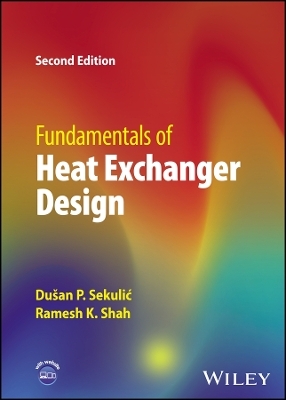
Fundamentals of Heat Exchanger Design
John Wiley & Sons Inc (Verlag)
978-1-119-88326-5 (ISBN)
Heat exchangers are thermal devices which transfer heat between two or more fluids. They are integral to energy, automotive, aerospace, and myriad other technologies. The design and implementation of heat exchangers is an essential skill for engineers looking to contribute to a huge range of applications.
Fundamentals of Heat Exchanger Design, Second Edition provides a comprehensive insight into the design and performance of heat exchangers. After introducing the basic heat transfer concepts and parameters, an overview of design methodologies is discussed. Subsequently, details of design theory of various types of exchangers are presented. The first edition established itself as the standard single-volume text on the subject. The second edition preserves an established in-depth approach but reflects some new technological developments related to design for manufacturing compact heat exchangers, including novel 3-D printing approaches to heat exchanger design.
Readers of the second edition of Fundamentals of Heat Exchanger Design will also find:
A new section on the design for manufacturing of compact heat exchangers
A new section on design for additive manufacturing compact heat exchangers
Detailed discussions of the design of recuperators and regenerators, pressure drop analysis, geometric parameters, heat transfer correlations, and more
Fundamentals of Heat Exchanger Design is ideal for practicing engineers, as well as for advanced undergraduate and graduate students in mechanical and aerospace engineering, energy engineering, and related subjects.
Dušan P. Sekulić, PhD, is the J.G. Morris Secat Aluminum Professor in the College of Engineering, Department of Mechanical and Aerospace Engineering, University of Kentucky. He has published extensively on heat transfer engineering, heat exchanger design, materials aspects of compact heat exchanger design, and related subjects. Ramesh K. Shah, PhD, has served as a Research Professor at the Rochester Institute of Technology and Senior Staff Research Scientist at Delphi Harrison Thermal System and General Motors. He has contributed widely to research publications on heat exchanger design and related subjects.
About the Authors xi
Preface to the Second Edition xiii
Preface to the First Edition xv
Nomenclature xix
About the Companion Website xxxi
1 Heat Exchangers: Semantics 1
1.1 Heat Transfer in a Heat Exchanger 1
1.2 Modeling a Heat Exchanger 5
1.3 Irreversibilities in Heat Exchangers 20
1.4 Thermodynamic Irreversibility and Temperature Cross Phenomena 27
1.5 Heuristic Approach to an Assessment of Heat Exchanger Effectiveness 35
1.6 Energy, Exergy, and Cost Balances in the Analysis of Heat Exchangers 39
1.7 Performance Evaluation Criteria Based on the Second Law of Thermodynamics 58
2 Overview of Heat Exchanger Design Methodology: The Art 63
2.1 Heat Exchanger Design Methodology 63
2.2 Interactions Among Design Considerations 77
2.3 Heat Exchanger Design for Manufacturing 78
3 Thermal Design for Recuperators 91
3.1 Heat Flow and Thermal Resistance 91
3.2 Heat Exchanger Design Variables/Parameters 93
3.3 The ε-NTU Method 105
3.4 Effectiveness-NTU Relationships 112
3.5 The P-NTU Method 128
3.6 P-NTU Relationships 131
3.7 The Mean Temperature Difference Method 157
3.8 F Factors for Various Flow Arrangements 161
3.9 Comparison of the ε-NTU, P-NTU, and MTD Methods 176
3.10 The υ-P and P1-P2 Methods 179
3.11 Solution Methods for Determining Exchanger Effectiveness 181
3.12 Heat Exchanger Design Problems 185
4 Relaxation of Design Assumptions. Extended Surfaces 189
4.1 Longitudinal Wall Heat Conduction Effects 189
4.2 Nonuniform Overall Heat Transfer Coefficients 200
4.3 Extended Surface Exchangers 213
4.4 Additional Considerations for Shell-and-Tube Exchangers 243
4.5 Flow Maldistribution 248
5 Thermal Design of Regenerators 283
5.1 Heat Transfer Analysis 283
5.2 The (ε-NTUo) Method 290
5.3 The Λ-Π Method 309
5.4 Influence of Longitudinal Wall Heat Conduction 319
5.5 Influence of Transverse Wall Heat Conduction 326
5.6 Influence of Pressure and Carryover Leakages 330
5.7 Influence of Matrix Material, Size, and Arrangement 336
6 Heat Exchanger Pressure Drop Analysis 341
6.1 Introduction 341
6.2 Extended Surface Heat Exchanger Pressure Drop 344
6.3 Regenerator Pressure Drop 354
6.4 Tubular Heat Exchanger Pressure Drop 354
6.5 Plate Heat Exchanger Pressure Drop 357
6.6 Pressure Drop Associated with Fluid Distribution Elements 359
6.7 Pressure Drop Presentation 371
6.8 Pressure Drop Dependence on Geometry and Fluid Properties 377
7 Surface Heat Transfer and Flow Friction Characteristics 379
7.1 Basic Concepts 379
7.2 Dimensionless Groups 394
7.3 Experimental Techniques for Determining Surface Characteristics 402
7.4 Analytical and Semiempirical Heat Transfer and Friction Factor Correlations for Simple Geometries 423
7.5 Experimental Heat Transfer and Friction Factor Correlations for Complex Geometries 458
7.6 Influence of Temperature-Dependent Fluid Properties 474
7.7 Influence of Superimposed Free Convection 477
7.8 Influence of Superimposed Radiation 482
8 Geometry of Heat Exchangers' Surfaces 489
8.1 Tubular Heat Exchangers 489
8.2 Tube-Fin Heat Exchangers 494
8.3 Plate-Fin Heat Exchangers 499
8.4 Regenerators With Continuous Cylindrical Passages 508
8.5 Shell-and-Tube Exchangers with Segmental Baffles 511
8.6 Gasketed Plate Heat Exchangers 519
9 Heat Exchanger Design Procedures 521
9.1 Fluid Mean Temperatures 521
9.2 Plate-Fin Heat Exchangers 524
9.3 Tube-Fin Heat Exchangers 547
9.4 Plate Heat Exchangers 548
9.5 Shell-and-Tube Heat Exchangers 560
9.6 Note on Heat Exchanger Optimization 578
10 Selection of Heat Exchangers and Their Components 581
10.1 Selection Criteria Based on Operating Parameters 581
10.2 General Selection Guidelines for Major Exchanger Types 587
10.3 Some Quantitative Considerations 606
Appendix A Classification of Heat Exchangers 631
Appendix B P-NTU Relationships 699
References 713
Index 725
| Erscheinungsdatum | 27.10.2023 |
|---|---|
| Verlagsort | New York |
| Sprache | englisch |
| Gewicht | 104 g |
| Themenwelt | Technik ► Bauwesen |
| Technik ► Maschinenbau | |
| ISBN-10 | 1-119-88326-1 / 1119883261 |
| ISBN-13 | 978-1-119-88326-5 / 9781119883265 |
| Zustand | Neuware |
| Informationen gemäß Produktsicherheitsverordnung (GPSR) | |
| Haben Sie eine Frage zum Produkt? |
aus dem Bereich


